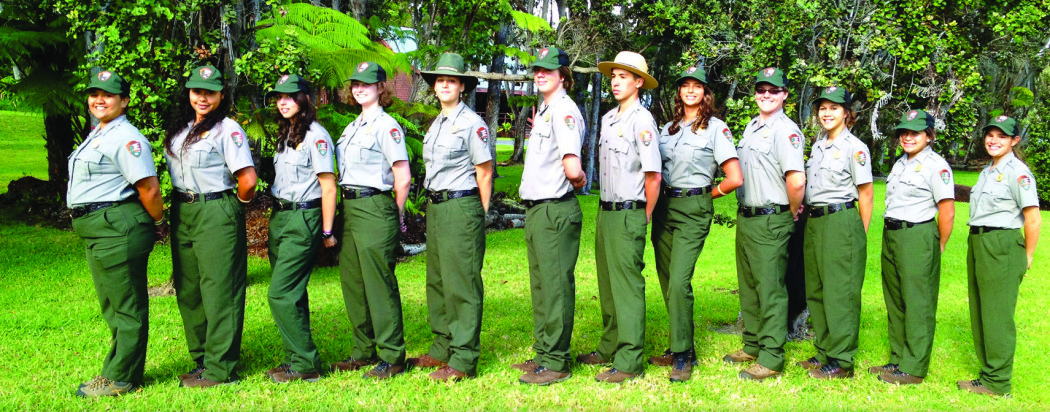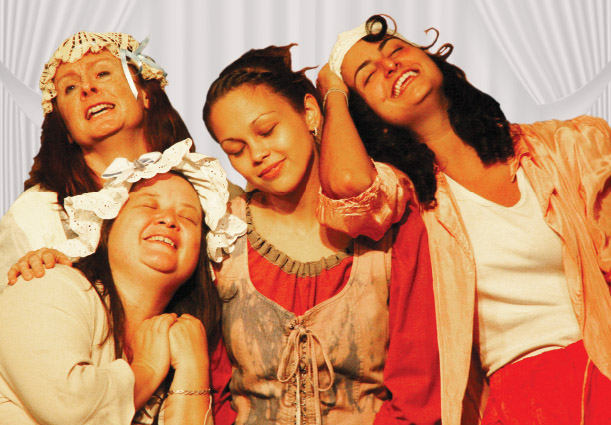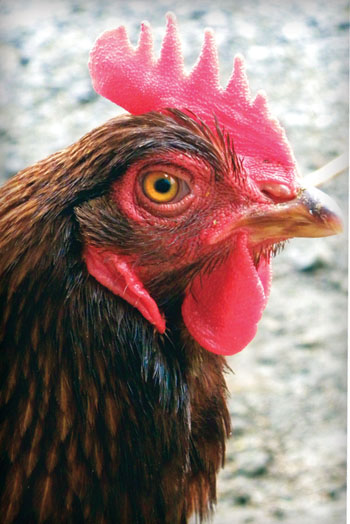
Youth Invade Volcanoes National Park with Enthusiasm: Internship Program, in its Third Year, Exceeds Expectations
 By Alan D. McNarie
By Alan D. McNarie
“I always thought that geology was just historic things in the past,” muses Tyler Atwood. “But here the volcano changes every day. The entire elevation of where you stand changes every day. They just paved Chain of Craters Road two months ago. But the pavement is already cracked….”
Something the youth may not have even pondered in the past, the sometimes-ephemeral nature of stone, is just one of the lessons that Atwood, a student at Ka‘ū High School, is learning this summer. He’s in his second year as an intern in Hawai‘i Volcanoes National Park’s Youth Internship Program.
The National Park program itself is in its third year now. Starting originally with students from Ka‘ū, it’s expanded to take in kids from Puna schools, as well, and has gotten some college students involved in working with the park staff to mentor the high-schoolers. With cooperation from schools in both districts, the teens in the program participate in weekly, two-hour class sessions for six weeks. They learn biology, geology, and native Hawaiian culture; they’re exposed to scientific methods, learn first aid and CPR, and get formal training in teamwork and communications skills. Then they go to the National Park for two more weeks of on-site training in the nuts and bolts of specific jobs within the park—from interpretation to fighting invasive species.
The icing on the cake for the interns is an actual summer job at Hawai‘i Volcanoes National Park. The youth get introduced to a possible career in conservation—one of the few fields that is still growing in Hawai‘i’s current economy, notes Kūpono McDaniel, supervisory ranger of interpretation, who runs the program. He also notes that interns learn basic organization, communication and “people” skills that can translate to other fields as well.
“We’re building the skill sets for our local people to be competitive,” maintains McDaniel. He notes that employers have told him, “Youthful people coming into a job, they don’t look people in the eyes when they speak to them….”
Kaysee Buchanan, a first-year intern, says she had that problem. “Before I was shy,” she says, “and now I’m more open to talk with strangers and share what I’ve learned.”
And by summer’s end, McDaniel says, “I think that they know they can do a job well, and have that pride under their belts, so that they can go out into the world and make a difference.”
Many of the students also gain what Atwood calls “a newfound appreciation for my home”—and the lesson spreads. Like New Yorkers who never visit the Statue of Liberty, Atwood’s family, he says, felt that “There’s really no reason to visit the National Park. We live here. But you bring your family up, you bring your friends up here, and just in a day, they can see what you’ve done, and it changes their outlook of it too. They go from, ‘We don’t need to go to the National Park,’ to ‘This is a special place.’”
Buchanan spent her early years in California, where, she admits, “Nature was a trip to the beach.” She says the program has given her a stronger bond with her new home—not only with its nature, but with its native culture.
“Hawaiian culture has lasted so long,” she says. “I think it’s our duty to keep it alive.”
She notes that it’s not just friends and family who catch the interns’ enthusiasm. Tourists can catch it, too. “It’s amazing how, when you talk to someone and share the knowledge that you’ve learned in this program, it impacts them, and then they care how concerned you are about it. They can sense it, and then they care as well,” she says. “They’re also awed by the fact that we are young, and that we know all this. It helps them respect the ‘āina, the land, a little more, and some of them do take action and get involved in conservation work as volunteers…. They realize that maybe there’s hope for their own areas, and they can relate to it scientifically and culturally.”
The park, too, benefits from having the kids there. The perpetually undermanned and under-budgeted park staff was boosted by 50 workers this summer, thanks to the intern program. And the interns aren’t just warm bodies; they have impressed the veteran rangers with their drive and élan.
“We had a meeting with people in the other divisions, and they were stunned at how really committed these students are to the park service through their six weeks in this pre-training,” says Ranger McDaniel.
When it first began, the interns worked mainly as interpretive rangers, guiding tourists and answering questions. But now they’ve expanded into other branches of the Park Service. Atwood, for instance, has gotten involved in the battle with one of the park’s worst invaders: kāhili ginger, a beautiful, extremely fragrant, yellow-and-red flowering ginger that was originally a native of the Himalayas, but got its Hawaiian name because of the flowers’ resemblance to the feather-bedecked staffs that were carried as emblems of Hawaiian royalty. Like many of the island’s plant pests, kāhili ginger was originally brought to the island to grace local gardens. Unlike other gingers, however, it thrives in shade, allowing it to invade native rainforests. It’s a fierce competitor, crowding out native plants and covering the forest floor with a dense layer of six-foot-high plants that produce thousands of seeds and grow an under-layer of rhizomes (the root-like parts that, in edible ginger, are used in cooking, but are inedible in kāhili ginger) that can be three feet thick. Cut down the stalks, and the plants will come right back from the rhizomes, making them extremely tough to kill, as many a Volcano Village resident can attest. But now Atwood knows how.
“We already took out five patches of ginger at least,” he says. “We just kind of chop it down and leave about three inches sticking up so we know where it is, and then come back about a week later and poison it.”
Some teens even work in law enforcement. “Students in the Law Enforcement Division learn that communication is the best tool for law enforcement. Those other tools that hang on your belt are as last resorts,” says McDaniel. Then he adds, quickly, “But we don’t give students guns and Tasers.”
McDaniel says the Youth Internship Program got started with a grant from the National Park Service’s Youth-in-Parks Initiative, because the Park Service had “found that youth were not really connecting with the parks as much” as they had in the past. The internship program helps with the problem in at least two or three ways. First, the interns themselves get involved with the park. Second, they help other young visitors to connect.
“When people come into the visitor’s center, they naturally connect with the ranger who looks most like them,” observes McDaniel.
And the young rangers also give their older mentors insights into how kids think.
“Students are helping the park with digital media, making sure that it makes sense to them, and not just people that are already connected to the park service,” McDaniel says. “A lot of conservationists think that everyone thinks like us….”
The program’s success has garnered it additional monetary and in-kind support from a variety of sources, including the Hawai‘i Community Foundation and the Hawai‘i Pacific Parks Foundation. Ka‘ū’s Edmund C. Olson Trust donated a van to transport kids to class, and Ka‘ū and Pahoa High Schools have provided classroom space. It’s a program that seems to leave just about everybody associated with it feeling good.
“For my own heart,” says McDaniel, “I wanted kids to know that there were jobs you could enjoy, be passionate about and go home at the end of the day feeling that you did some good for the planet.” ❖
Contact Kūpono McDaniel: Kupono_McDaniel@nps.gov
Contact writer Alan McNarie: amcnarie@yahoo.com


